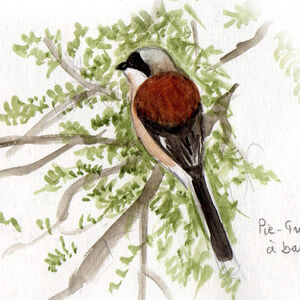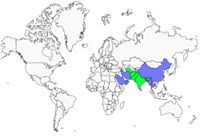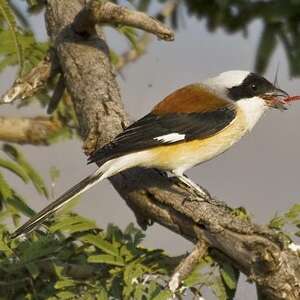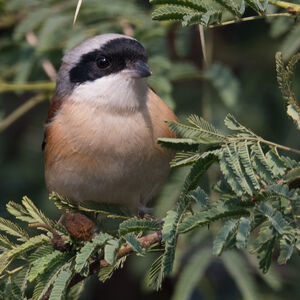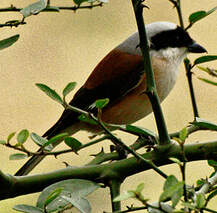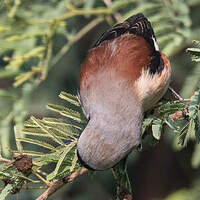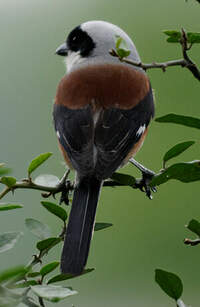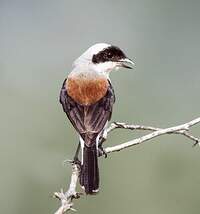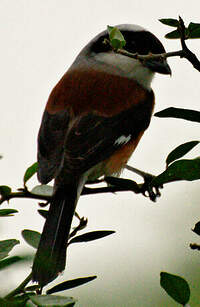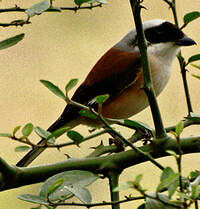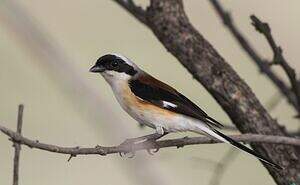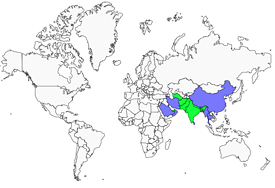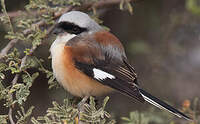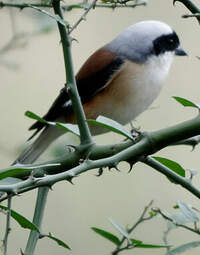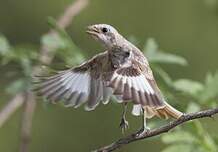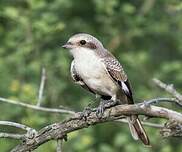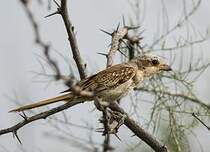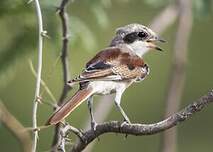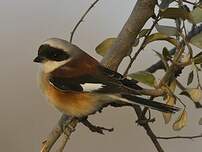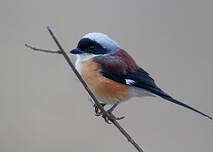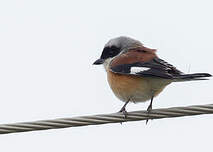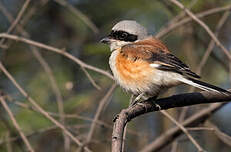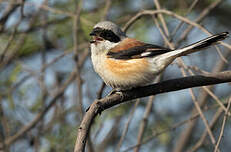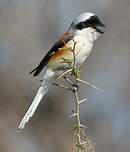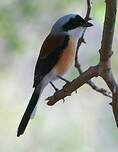Bay-backed Shrike
Lanius vittatus - Pie-grièche à bandeau
Identification
The Bay-backed Shrike can be considered as a distant cousin of our Lesser Grey Shrike, the aspect and colors being quite similar. Lanius vittatus measures from 17 to 19 cm, its first distinctive mark is its black mask, shaped like a band, covering the forehead, eye (also black) and auricular zone, a true flying Zorro! The crown and nape are light grey, contrasting with the mantle and shoulder feathers brown-red. The coverts and the flight feathers are black or gray-anthracite with a characteristic white spot on the primaries. Fine white stripes appear on the margins as well as at the level of the first primary. The rump is gray to finish on a fairly long black tail. The chin, throat and belly are white, while the flanks and abdomen are delicately colored cream or light brown, the under tail feathers are white as well as the lower rectrices. The beak and legs are black. There is no sexual dimorphism, the young have a narrower gray band on the head, the crown is light brown, marked with small darker streaks, all the contrasted colors of the adult are more diluted, so the coverts are gray instead of being black and the back and mantle dirty brown instead of the beautiful brown-red of the adult.
Subspecific information 2 subspecies
- Lanius vittatus vittatus (c and s Pakistan to s Nepal and c and s India)
- Lanius vittatus nargianus (se Turkmenistan to se Iran, Afghanistan and w Pakistan)
Foreign names
- Pie-grièche à bandeau,
- Alcaudón dorsicastaño,
- picanço-de-dorso-castanho,
- Rotschulterwürger,
- vörösvállú gébics,
- Bruinrugklauwier,
- Averla dorsobaio,
- indisk törnskata,
- Indiavarsler,
- strakoš vavrínový,
- ťuhýk indický,
- Brunrygget Tornskade,
- intianpikkulepinkäinen,
- escorxador emmascarat,
- dzierzba maskowa,
- brūnplecu čakste,
- Индийский жулан,
- クロビタイセアカモズ,
- 褐背伯劳,
- 棕赤背伯勞,
Voice song and cries
Habitat
The Bay-backed Shrike is all-terrain, it is found at the edge of forests, in open areas dotted with shrubs and hedges. In the northwest of its range, it is found in semi-desert areas, in Iran in pistachio plantations. Further south, it approaches to cultures and dwellings, and is visible in parks and gardens. It prefers the sea level, but it is seen up to 3,900 m in Nepal.
Behaviour character trait
Subspecies nargianus appears to be a migrant. In southern Turkmenistan, they leave their breeding grounds in August and September to travel to India and come back in April.
In Pakistan, the northern individuals leave for the south in October and come back in March. Subspecies vittatus, which is the nominate species, is a resident in all of India, although some individuals from the north may move south occasionally. Isolated observations have been made in Sri Lanka, Saudi Arabia, Oman or Bhutan, but are surely due to single birds.Dietfeeding habits
Bay-backed Shrike is an insectivore, hunting for beetles, grasshoppers, and any other insects that come into reach. Its diet is supplemented by lizards, small rodents, and occasionally other passerines. It is often spotted perched on a small branch, electrical cable or post, from which it dives onto its prey. Like many other shrikes, it attaches its prey to thorny bushes for better tearing.
Reproduction nesting
The breeding periods will vary according to the location, from May to July in Turkmenistan, from March to August in Pakistan.
In India too, the periods differ: in the northwest from April to July, from February to September in the center, and from February to April in the south. The Bay-backed Shrike can reproduce two to three times a year. Generally a solitary nester, couples can cohabitate more closely depending on the abundance of prey (up to 50 m, in the best cases). The nest is in a bowl shape, 10 cm in diameter, built with plants, feathers, fiber plants, and wool strands found near flocks; located between 1.5 and 4 m high in trees or large shrubs. The bird fondly builds its nest in acacias, and almost exclusively its nest in pistachios in Turkmenistan! The clutch is of 3 to 5 eggs, white with pale shades of pink or green. The incubation is carried out by the female who is fed by her partner for 15 days. The chicks stay 15 days in the nest and are fed by their mother with the prey brought by the male.Geographic range
At the southeast of Turkmenistan and Iran, in Afghanistan and at the west of Pakistan, is found the subspecies nargianus with a less distinct band and paler brown shades. The more well know subspecies vittatus is located at the east of Pakistan, at the south of Nepal, and throughout the Indian subcontinent.
Threats - protection
Sources of information
- IOC World Bird List (v14.1), Gill, F and D Donsker (Eds). 2024-04-18.
- A Field Guide to the Birds of the Indian Subcontinent, Krys Kazmierczak, Ber Van Perlo
- A Photographic GUIDE TO THE BIRDS OF INDIA, Bikran Grewal, Bill Harvey, Otto Pfister
- Vol 13- Handbook of the birds of the world, del Hoyo J., Elliott A. Christie D.
- ARKive, Christopher Parsons
- Oriental Bird Club,
- THE AVIANWEB, Sibylle Faye
- Wikipédia, Wikipedia, The Free Encyclopedia
Other sources of interest
 Specification sheet created on
01/08/2023 by Anne et Gabriel Leboff
Specification sheet created on
01/08/2023 by Anne et Gabriel LeboffTranslation by AI Oiseaux.net
published: 08-05-2013 - Updated: 28-03-2016
© 1996-2024 Oiseaux.net
- Accipitriformes
- Aegotheliformes
- Anseriformes
- Apodiformes
- Apterygiformes
- Bucerotiformes
- Caprimulgiformes
- Cariamiformes
- Casuariiformes
- Charadriiformes
- Ciconiiformes
- Coliiformes
- Columbiformes
- Coraciiformes
- Cuculiformes
- Eurypygiformes
- Falconiformes
- Galliformes
- Gaviiformes
- Gruiformes
- Leptosomiformes
- Mesitornithiformes
- Musophagiformes
- Nyctibiiformes
- Opisthocomiformes
- Otidiformes
- Passeriformes
- Pelecaniformes
- Phaethontiformes
- Phoenicopteriformes
- Piciformes
- Podargiformes
- Podicipediformes
- Procellariiformes
- Psittaciformes
- Pterocliformes
- Rheiformes
- Sphenisciformes
- Steatornithiformes
- Strigiformes
- Struthioniformes
- Suliformes
- Tinamiformes
- Trogoniformes

